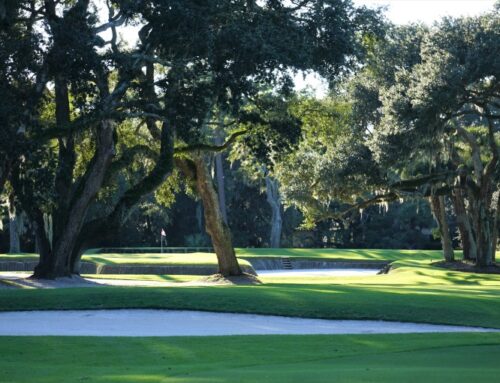Oakmont Country Club
PA, USA
Green Keeper: John Zimmers
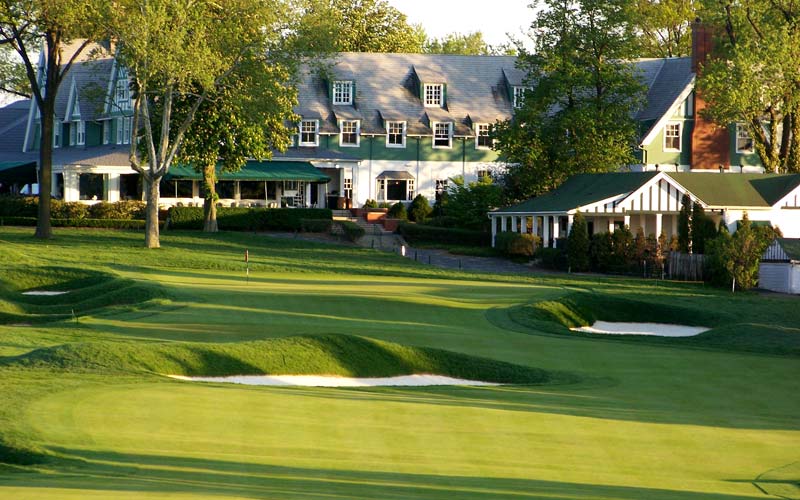
Beauty and …

…the beast: welcome to Oakmont.
In the 1960s, Oakmont Country Club underwent a massive tree planting campaign that changed the nature of the course. Oakmont nearly became a pretty parkland course, a description that surely would have its founders Mr. Henry C. Fownes and his son William Fownes Jr. spinning in their graves.
Since the 1994 U.S. Open won by Ernie Els, all that has mercifully changed. After a 1995 presentation to the club board by member Mark Studier a path was charted that would return Oakmont to Henry and William Fownes’ founding vision of a raw links that examined a golfer’s game like no other.
Headlined by a decade long tree removal program that saw over five thousand trees removed, Oakmont has been restored as one of the world golf’s most individualistic courses. Like Carnoustie and Royal Liverpool, there is something appealing in the course’s desire to be unappealing. It is the Charles Bronson of golf courses – no special effects are necessary.
Some clubs like Augusta National Golf Club show little interest in their founding fathers’ vision of good golf. This is most sad as such visions are often so unique as to have inspired the creation of the course in the first place. Heading into the 2007 U.S. Open, William Fownes and Henry Fownes’s would be rightly proud of the test that Oakmont will present.
An avid golfer who qualified for five U.S. Amateur Championships, Henry.C. Fownes decided at the turn of the twentieth century to start a golf club. In 1903, Henry Fownes found property well suited and oversaw the purchase of nearly 200 acres of pastureland above the town of Oakmont. The property was open in nature and remained so through the 1950s. Grantland Rice wrote in 1939 that he enjoyed the view of seventeen of Oakmont’s eighteen flags from the clubhouse porch (only the 16th obscured by a hill was out of view).
Henry Fownes and his team of 150 men and 25 donkeys constructed a course over the open farmland that resembled the unobstructed sweep of a links course. At the time of construction, the Haskell ball was making its presence felt and Henry Fownes recognized that the gutta-percha days were quickly ending. Consequently, he built the course to handle this new technology. When it opened in 1904, Oakmont had a par of 80 and was over 6,400 yards in length, a very long course for its day. Much to the credit of Henry C. Fownes’ feel for the land, today’s holes occupy the same general playing corridors as his original routing. Well under one hundred bunkers were constructed and Henry Fownes relied more on the natural landforms to present the challenge. The original scorecard shows the twelfth hole at 560 yards with a bogey of six (!) while the 225 yard sixteenth had a bogey of four.
Without doubt, Henry Fownes ruled the club and its running up until near his death in 1935. However, his son William C. Fownes Jr. was the one that saw to much of the design’s evolution (always with Henry Fownes’s blessing) from when it opened until his death in 1950. For instance, by the time the U.S. Open was played here in 1935 (the winning score was +11!), the course had over 300 bunkers, largely courtesy of William C. Fownes.
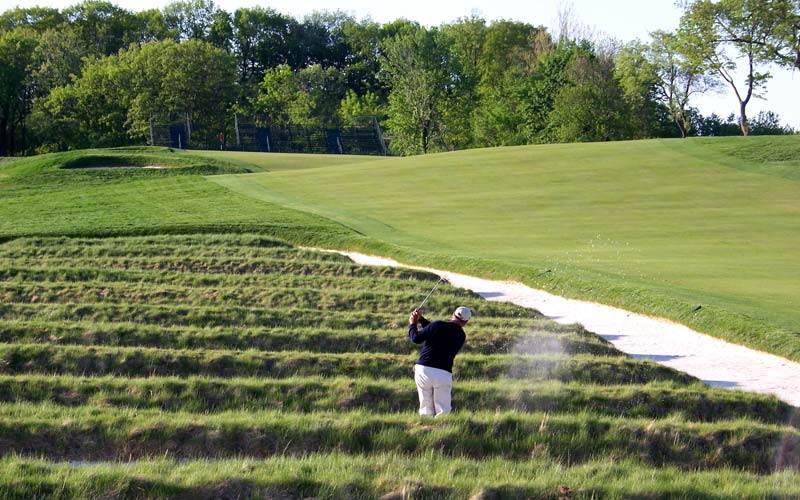
Even without furrows, the bunkers at Oakmont remain uniquely penal – and in play. The Church Pew bunker originally had seven pews. Today, it has twelve and extends more than 130 yards and covers 26,000 square feet. The golfer above has no prayer of reaching the third green, some 200 yards away.
William C. Fownes is one of the great figures in amateur golf and one of the giants in the development of golf in the United States. An accomplished player (he won the U.S. Amateur in 1910), he also the playing captain of the Walker Cup team in 1922 and served as president of the United States Golf Association in 1926/1927. In addition, he served on the advisory panel at Pine Valley and helped guide that club after George Crump’s death. However, his most important and lasting contribution to the game was the continual refinements he made to his father’s design at Oakmont.
William C. Fownes spent over four decades getting to know the course and observing how it played. If a particular bunker was rendered ineffective through time (such as the advent of steel shafts in the 1930s), he did not hesitate in working with the legendary Green Keeper Emil Loeffler to build another one further up the fairway to ensure that the integrity of a hole was preserved. William C. Fownes and Loeffler made a formidable team, both in the construction of bunkers and in imbuing the greens with some of the most imaginative interior contours for putting surfaces on this side of the Atlantic. Loeffler accentuated the design’s merit by setting new standards for fast and firm playing conditions in the United States.
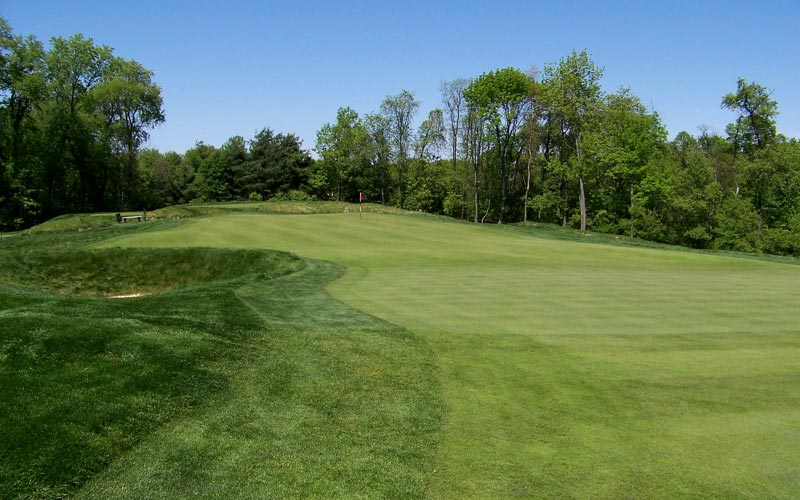
The checkered mowing pattern and the sheen of the grass fifteen yards and in toward the fifteenth green speak to the firm, tight playing conditions that Oakmont seeks and that Zimmers provides.
Appreciating the unique commitment and attention to detail that the Fownes family had brought to Oakmont, in the mid 1990’s the club examined its past for its future. Working from a 1949 aerial photograph (Loeffler died in 1948 and William C. Fownes in 1950), Studer and the club decided to bring back as many features as possible. The tree-clearing program was the most visible change. Not only did it re-open wonderful views across the rolling property, it introduced the full effects of the wind on one’s round. Oakmont once again possesses the barren landscape reminiscent of links courses that so impressed William C. Fownes during his travels to the United Kingdom.
With the trees gone, fairway width was recaptured. Bunkers and ditches are once again perilously close to the edges of the fairways. Though the well-known furrows in the bunkers were gone within five years of William Fownes’ death, Oakmont’s bunkers are justly famed. Fownes often repeated quote that ‘a poor shot should be a shot irrevocably lost’ is a clear sign that he thought bunkers should penalize. Indeed, they should be hazardous. However, given the clay subsurface, Fownes couldn’t dig the bunkers very deep into the ground due to construction and drainage constraints. So, he made the bunkers relatively small, along the lines of pot bunkers found in the United Kingdom. Getting a good stance can be problematic. Also, the dirt that was dug out was sometimes used to build up the wall of the bunker between the golfer and the green. Great such examples are the bunker 100 yards shy of the fourth green and the bunker 250 yards off the tee on the left of the fifth fairway. In such cases, the bunkers play much deeper than they actually are. The sheer number of bunkers – 312 bunkers at one point – speaks as to the challenge that was intended.
Crucially, great attention was paid to recapturing the greens’ full dimensions during the club’s restoration by carefully analyzing a 1949 aerial. In doing so, many of the course’s most exacting hole locations were re-gained, including back right at the second and front left at the ninth. Oakmont’s greens are legendary and kept as fast and firm on a daily basis as any in world golf. The variety found within them is astonishing. Some of the most undulating (e.g., the second and fifth) reflect the natural topography while others (e.g., the ninth and 18th) have apparently random rolls, plateaus and valleys. Importantly, others (e.g. the third and eighth ) are relatively flat with more subtle breaks. Several (e.g. the first, third, 10th and 12th) slope front-to-back. Some are tilted right-to-left (e.g. the fifth, sixth and 13th) and some left-to -right (e.g. the seventh and 16th). Finally, a few are pitched more traditionally back-to -front (e.g. the 11th and 17th). The golfer must be keenly aware of each green’s character and play accordingly; being above the hole at Oakmont is a start toward ruin. One thing is sure: the all encompassing variety of the greens at Oakmont makes modern greens with their typical back-to-front pitch monotonous, boring and poorly-conceived.
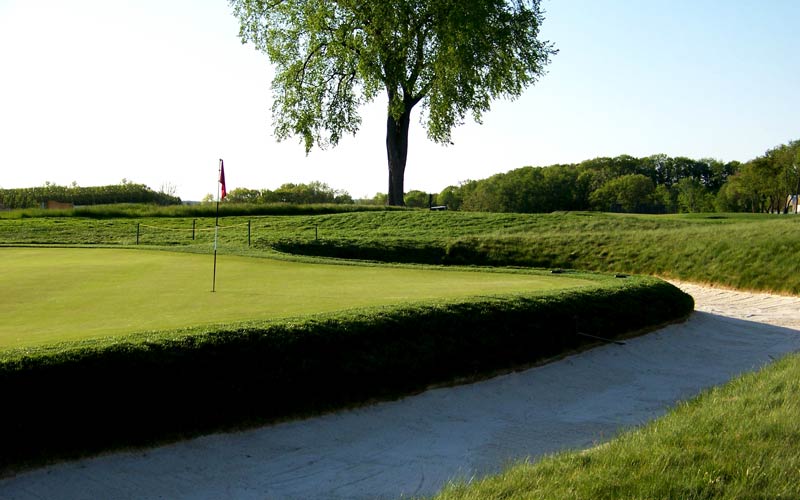
This back right hole location on the second hole didn’t exist in the 1970s when the putting surface stopped just shy of the hole location pictured above.
Holes to Note
1st hole, 480/440 yards; The opening hole reveals several of Oakmont’s unique characteristics. First, the five small bunkers along the immediate left of the fairway are below the grade of the land and their position is not readily known to the golfer. Second, the hole follows the flow of the land and if one’s approach shot is blind over the crest of the hill to the green well below, so be it – Oakmont never pretends that the game is supposed to be ‘fair’ with perfect visuals. Featuring a fierce back sloping green, only the opening holes at Crystal Downs and Winged Foot West rival it for the hardest opener in golf. Third, John Zimmers and his crew deserve great credit and recognition for the area forty yards and in to the putting surface. The approach areas across the course are as firm and fast as any of the links in the United Kingdom. Much of golf’s timeless appeal is found in playing the ball along the ground and the quality of the turf at Oakmont greatly enhances this primal experience.
2nd hole, 340/325 yards; Like Pine Valley, Oakmont is far more than a penal course – it is position golf at its most exacting. Take the second green – the most fiercely sloping one on the course – where an approach shot above the hole becomes a matter of survival. Strategically, this angled green is best approached from the right third of the fairway, where a nest of six bunkers meddle.

The ditch on the left and the bunkers right pinch the fairway 130 yards from the green. Ideally, the golfer carries the bunkers off the tee and gains the best angle into the green.
3rd hole, 430/390 yards; Though equally penal bunkers are down the right, the famed Church Pews loom left and dominate the golfer’s eye. This innovative and thoroughly unique bunker complex remains every bit as penal today as it was when William C. Fownes oversaw its construction in the 1930s. Its randomness – one day the golfer may draw a respectable lie/stance between the pews and the next, face ruin – has scared golfers for decades. While less dramatic, the green complex atop a knoll is equally unique in that it features one of the game’s very few uphill approaches to a green that slopes away. Precision is crucial – land short and the ball may come back fifteen yards off the false front; carry too far onto the green and the ball rolls over. The slope behind the green wasn’t maintained as short grass in William Fownes’ day now terrorizes good golfers as much as rough; no doubt, Fownes would approve.

Give H.C. Fownes plenty of credit for beautifully draping the third hole across some of the best land on the property. The famed Church Pew bunkers didn’t appear for a few decades.

The perfectly placed third green sits atop a knob.
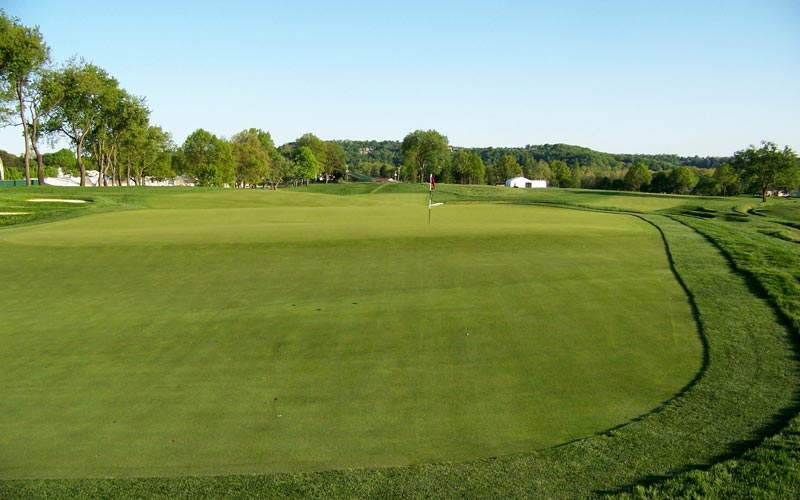
As seen from behind, the front-to-back sloping third green feeds balls onto this closely mown area.
4th hole, 610/510 yards; W.C. Fowne’s ability to define quality golf at Oakmont is well-displayed in the playing angles of this twisting hole. First, the downhill tee shot must fit between the Church Pews on the left and a set of small, deep bunkers that protrude in from the right. The second shot is over the brow of a hill, creating uncertainty. The best angle of approach into the green is from the right of the fairway, exactly where W.C. manufactured several steep bunker walls.
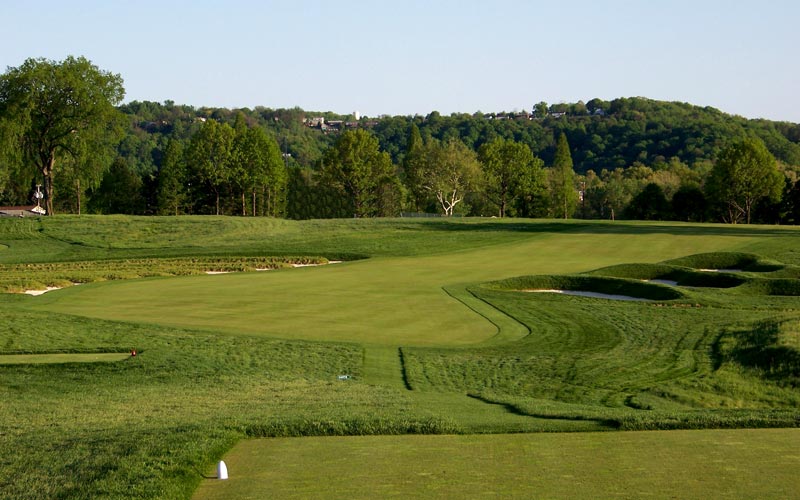
The golfer dearly loves to shorten the fourth by playing over the five bunkers on the right.

A pulled drive into the Church Pews is certainly no good. Also, as seen above, the fairway disappears over the crest of the hill…
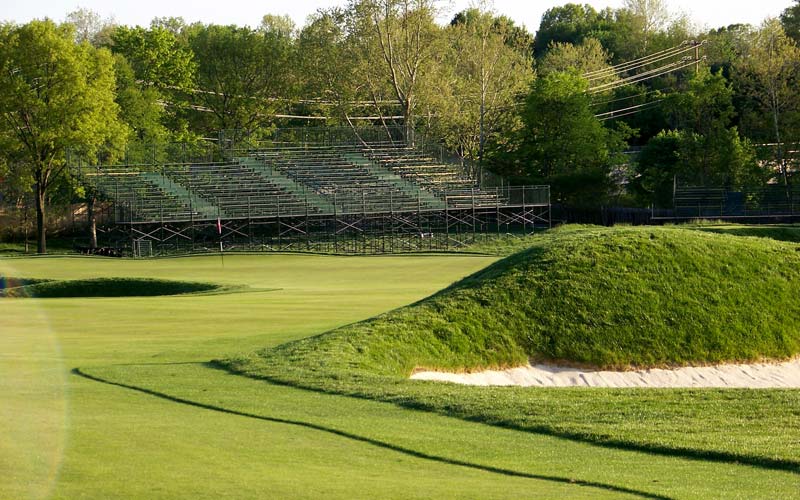
…creating uncertainty as to just how far right to lay up. The bunker above perfectly guards the best angle into the green. Note how the bottom of the bunker is less than two foot below ground. However, its built-up wall makes recovery more than a little daunting.
5th hole, 380/350 yards; H.C. Fownes captured the landforms to create so much variety that the golfer barely notices that many of the holes at Oakmont go back and forth and are parallel to their predecessor. Here, the fairway runs out 290 yards from the tee and gives way to broken ground. On the far side of a valley where ditches lurk, Fownes placed the green. Six bunkers around it creating a virtual island. While spacious for a hole of modest length, the green, appropriately, features some of the more severe contours on the course.
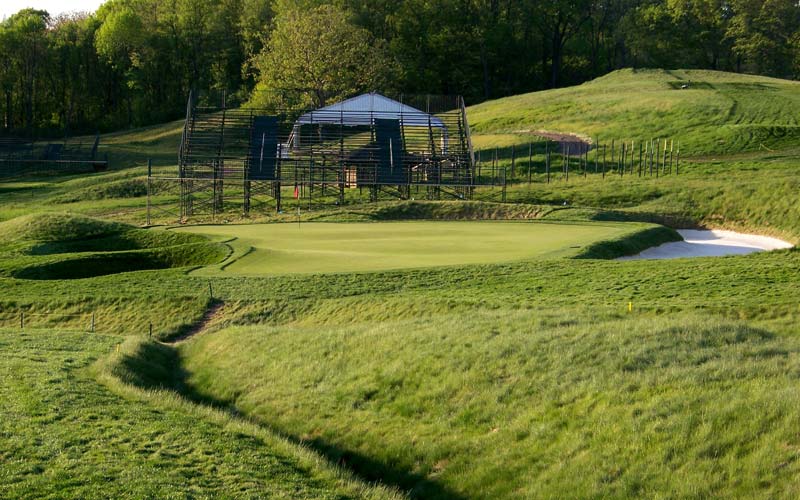
Unlike a lot of greens at Oakmont, the fifth accepts only an aerial approach. The fact that the green’s interior contours are visible from 100 yards away should concern the golfer.
6th hole, 195/170 yards; The long slender green is severely sloped from right to left. Short-siding a right hole location becomes a test of making a twenty footer. Tom Doak eloquently sums up the hole perfectly: ‘ I’ve never understood why water to the right of a green is acceptable but rough and a tilted green that make it impossible to get up and down from the right are ‘unfair.”
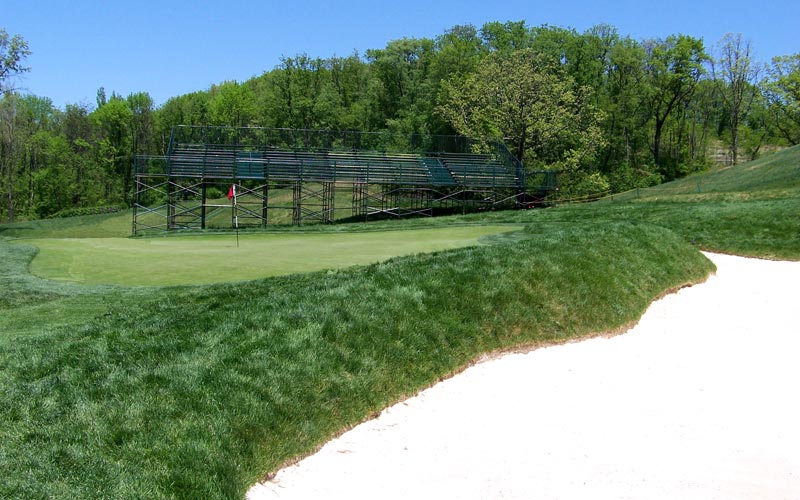
The right to left pitch of the sixth green is evident in this photograph.
7th hole, 480/370 yards; This hole’s difficulty has changed the most since H.C. Fownes laid out the course. Originally 370 yards, a new back tee high on the rim of the property allows this hole to play 480 yards, albeit with a sharply downhill tee ball. The playing angles have remained the same; the hole is rifle straight from tee to green, not atypical for an Oakmont two-shotter. Bunkers left and right of the fairway highlight Oakmont’s high-demand architecture. The artistry in the hole’s design is at the green complex where a left-to-right tilt is in fine contrast to the prior two greens.
8th hole, 290/225 yards; Nearly all the great architects during the Golden Age of golf design featured a long one- shotter. Examples of excellent holes in the 220 to 240 yard range built during the 1910s and 1920s are too numerous to mention. In those days of hickory golf, such holes required either a three wood or driver. Time and the ceaseless march of technology has reduced the same length holes to only a mid or long iron shot for the game’s best. Many of the classic old courses don’t have room to expand their holes but Oakmont did and took full advantage by lengthening this hole to nearly 290 yards in preparation for the 2007 U.S. Open. The whining and howls of protest from the world’s best for its rigors would have fallen on deaf ears to H.C. and W.C. Downes who intended that a driver to be hit here and designed the hole accordingly. The green and its contours are (relatively speaking given that the greens often stimp above 13!)among the more modest on the course. A hundred yards long Sahara bunker is visually dominating but quite shallow. Furthermore, on a direct line, there is forty-three yards of open fairway past to the front of the open green which sits at grade.
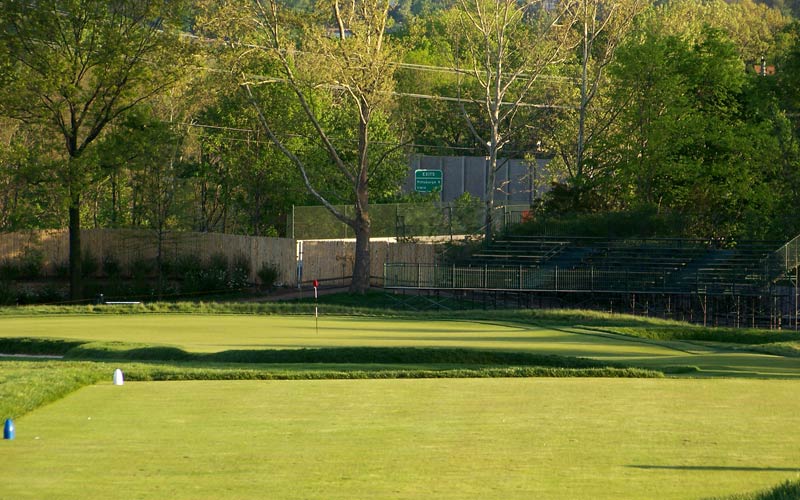
What’s all the fuss about playing this hole at 290 yards? It is across modest terrain and when Oakmont opened, it was 220 yards and required a driver or third wood, same as today.
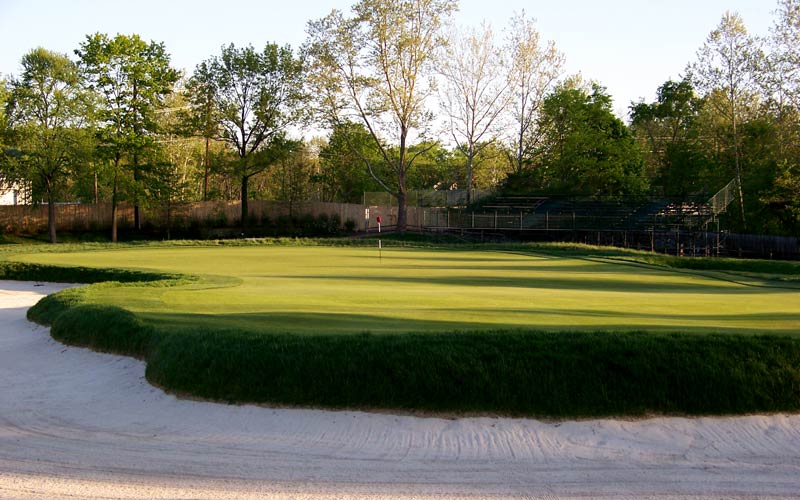
Additionally, the eighth was designed to accommodate a long approach as there is plenty of room past the Sahara bunker to land one’s tee ball and have it run onto the green.
9th hole, 475/460 yards; Another example of H.C. Fownes’ prescience can be found in his placement of this green at the base of the clubhouse. It hardly seems surprising today but when he routed the course in 1903, it was not customary to return both nines to the clubhouse. Indeed, given how sharply it plays uphill, others might have routed a hole ninety degrees to its right. As it is, the back of the green constitutes the practice putting green, giving members on the clubhouse’s long porch plenty to observe on the 22,000 square feet of prepared putting surface. Others have copied this notion of a shared putting surface but none nearly as well.
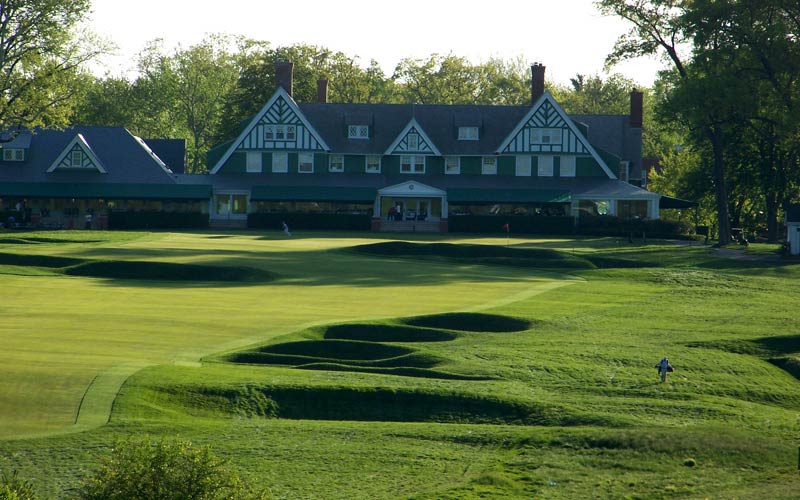
The ninth returns the golfer to the clubhouse.
10th hole, 460/440 yards; In the last twenty U.S. Opens of the 20th century, Oakmont’s tenth ranked behind only the awkwardly converted seventeenth hole at Olympic in playing the most over par. Indeed, the two hardest pars at Oakmont feature the same, great design – a green that slopes away from the player on a long two shotter. Like the first hole, the approach shot here is endlessly fascinating and distinguishes the player who’s thinking and executing well. On one’s approach, the ball must be crisply struck from a downhill lie in order to generate spin for control but the golfer must also judge just how short of the green to land it. As with all of Oakmont’s greens, the tenth is set just where it belongs as a natural extension of the fairway and is devoid of any sign of being forced upon the land. Building up such a green to ‘better’ receive the approach would be a crime, just as would altering any of the numerous greens at The Old Course at St. Andrews that slope from front to back.
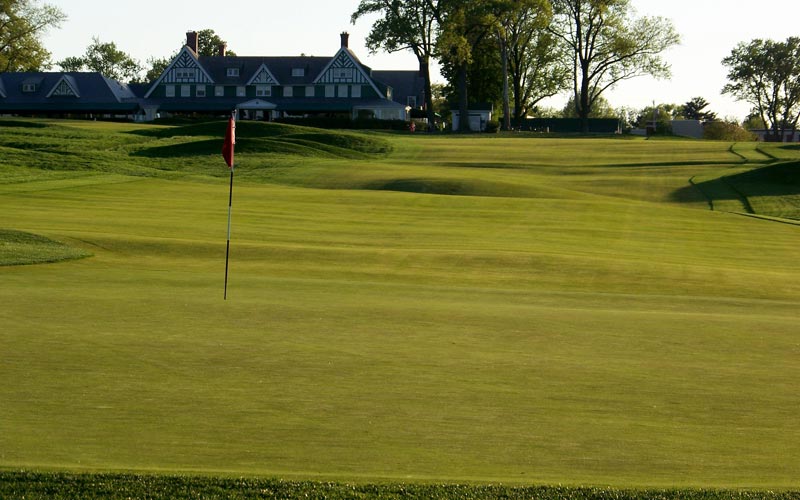
This view up the tenth shows how the green is a mere extension of the fairway. So simple, yet the front to back nature of the green gives players fits.
11th hole, 380/330 yards; Highlighting the ebb and flow in the sequence of holes at Oakmont is this finesse hole, sandwiched between the bruising tenth and twelfth holes. One of Oakmont’s famed ditches slashes across the fairway on a right to left diagonal to complicate the golfer’s lay-up which must find the fairway. The steeply pitched back to front green insists the pitch be carefully gauged to finish below the day’s hole location.

An ideal tee ball at the eleventh leaves this 115 yard pitch.
12th hole, 665/560 yards; Some three shotters like the 16th at Firestone or the last two at Wentworth (West) achieve recognition because of where they are in the round rather than merit. The opposite is true of this stupendous three shotter as it is too early in the back nine to garner the full attention it deserves. Four fairway bunkers short right and two longer left set up the tee shot beautifully. The left to right cant of the fairway creates real worry for the tiger who fears losing control of his ball along the fast running fairway. Ditches on either side of the fairway and a cross bunker 155 yards from the green define the second shot. If the golfer gets past the cross hazard, a well-struck pitch gives him a chance of seeing his ball finish close on this green that slopes from front left to back right. An approach from the rough is guaranteed to roll off the back of this long green. Who can forget Tom Watson’s chip from the rough short-left of the green that took almost a full minute to roll from the front of the green to its back hole location in the 1983 U.S. Open?
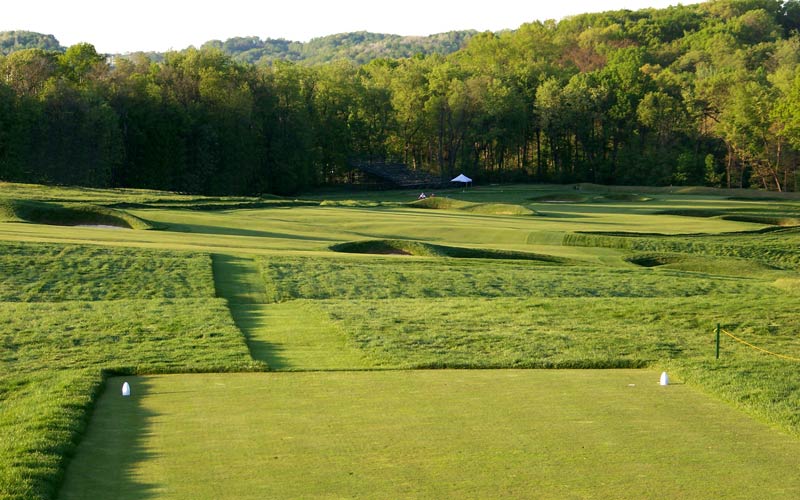
The bunkering scheme and the front to back slope of the green make the twelfth a world class three-shotter. However, even before such refinements were made, H.C. Fownes’ use of the left to right sloping terrain was quite noteworthy by itself.

Caught in the high left bunker off the tee, the golfer needs to hit a good recovery to get within 200 yards of the green. Note the smaller contours throughout the fairway, a lasting benefit of using horses and mules during construction as opposed to heavy machinery.

The golfer wants to spin a short iron into the twelfth green in an effort to control his ball on the front to back sloping green. To do so he must carry the cross hazard (above) that juts into the fairway 155 yards from the green.
13th hole, 185/155 yards; Every architect should study this hole. Constructed in a field with no natural landforms, the hole seems innocuous as it rests easily on the land. Yet, it requires an exacting shot. Part of the challenge lies in the fact that it is the narrowest green on the course. Also, ala the third green at Pine Valley, anything right is dead thanks to the green’s severe right to left tilt that is married to a long deep bunker down the green’s right. Like the one-shot sixth, the ability to hit a high fade off the tee and hold the ball against the green’s slope is a wonderful attribute – no wonder the great Nicklaus found the course to his liking in the 1962 U.S. Open!
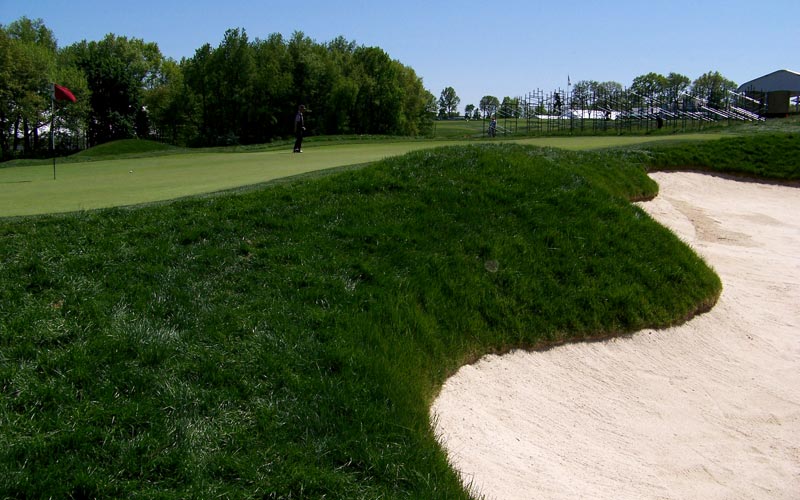
The thirteenth’s narrow putting surface is captured in this view from the right greenside bunker.
14th hole, 360/340 yards; For a feared course, the golfer is surprised to find four two shot holes that measure less than 400 yards. This is the third such hole and ten bunkers line the fairway indicating that Fownes expected the golfer to be penalized for missing a fairway with his three wood. Surprisingly, the green, 46 yards long, is the course’s second biggest. Modulating one’s pitch to get close to the hole on a large green presents the same challenge that has confounded golfers for over a century at St. Andrews.

As seen from behind, the large fourteenth green comes at the end of a narrow, bunker-lined fairway. The back hole location behind the ‘puff’ in the green is particularly tough to which to get close.
15th hole, 500/435 yards; Pat Ward-Thomas’ selection of this hole for his world eclectic eighteen was an easy choice. One of the game’s finest greens is the longest on the course and appears immense from the fairway. The course’s second longest bunker at 90 yards frames the green on a diagonal angle along its right side. That this built-up green complex looks so natural is testament to W.C. Fownes’ eye and Emil Loeffler’s ability to translate that vision. Their relationship began in 1904 when a ten year old Loeffler caddied for Fownes Jr. By 1927, Loeffler was both club professional and green keeper at Oakmont. Because the two walked and worked side by side for over four decades (!) at Oakmont largely explains why each hole is so special today. The course evolved; they didn’t create this green complex until sometime after 1925, two plus decades after the course opened.

Mini Church Pew bunkers guard the high left side of the fairway 220 to 160 yards from the fifteenth green.
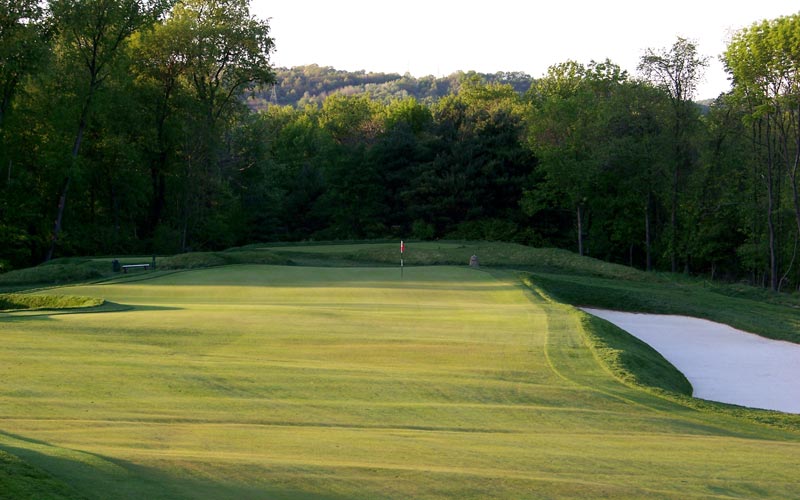
The world class fifteenth green complex is evidence as to how a course evolves over time through careful study. Originally the green was to the left and lacked the fascinating angles of play that it possesses today.
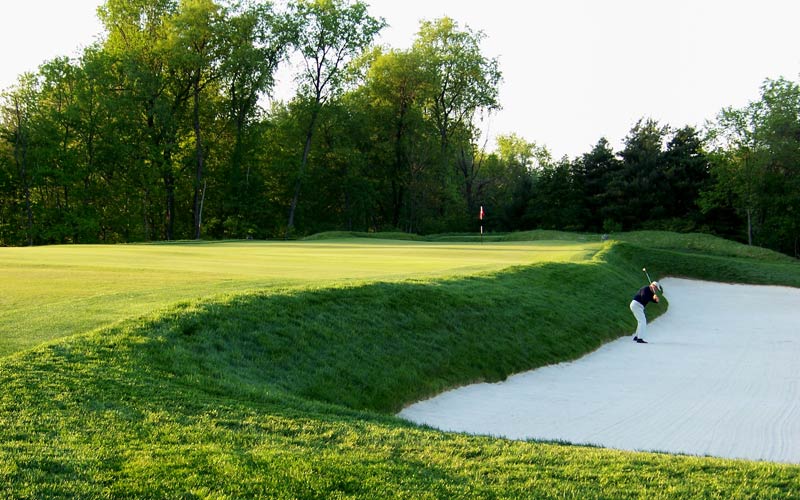
After removal of the interior trees the wind’s effect on play increased. On the fifteenth, the predominate wind sweeps from left to right.
16th hole, 230/210 yards; Similar to thefifteenth hole, the green complex was seamlessly benched into the sloping left to right hillside. Again, the golfer is encouraged to hit a high fade to feeds his ball onto the putting surface. Trees once surrounded the back and right of the green and branches nearly hung over the putting surface. One of the biggest benefits of tree removal was the unmasking of the green’s foreboding fall-off right and long.
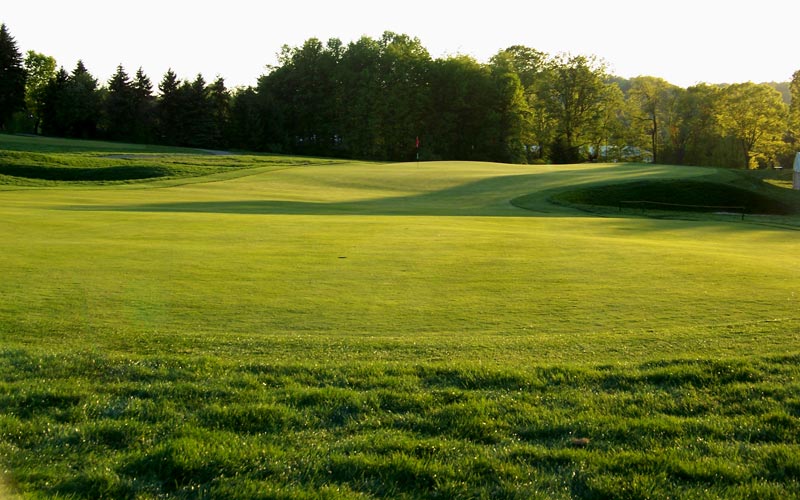
Once shrouded in trees, the sixteenth green complex now shines.
17th hole, 315/295 yards; This hole has continued to improve with time so that it is now among the game’s great dozen or so short two-shotters. The uphill green is within reach for big hitters but the deepened greenside bunkers, especially Big Mouth, counteract the desire to have a go. The resulting conundrum and that this risk/reward option occurs on the penultimate hole is wonderful indeed.
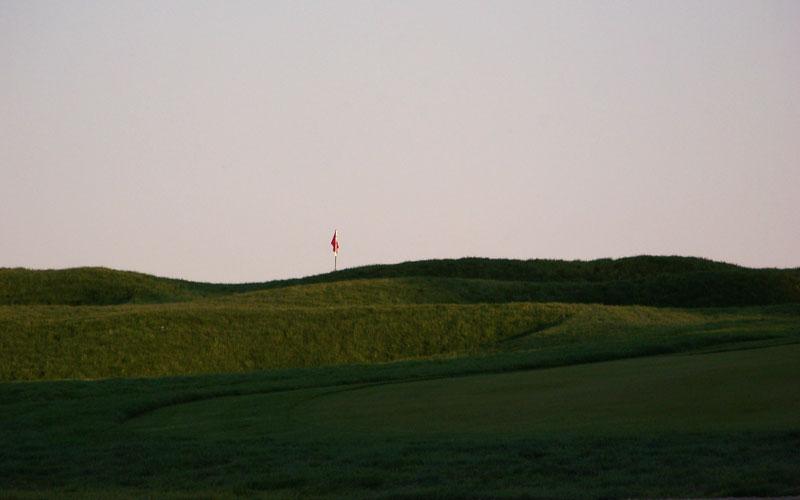
The flag at the uphill dogleg left seventeenth goads the player into having a go.
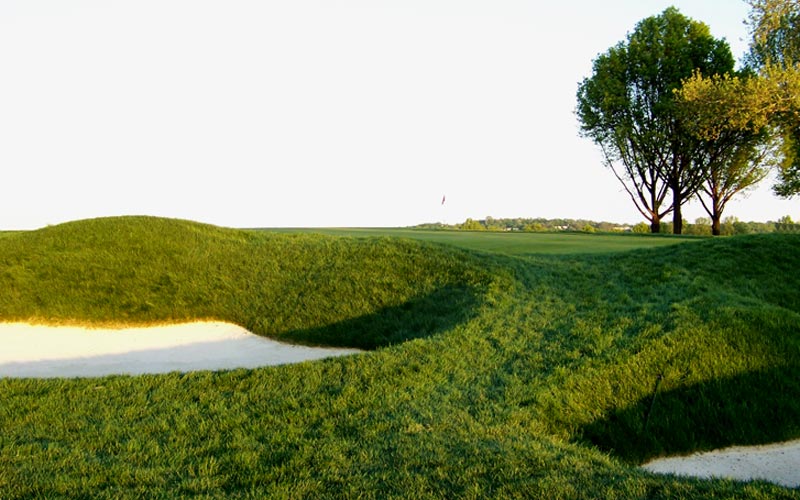
The direct line from tee to green means carrying six bunkers. If the golfer’s tee ball carries the last two as seen above, he still needs to…

…be mindful that his tee ball doesn’t leak right into Big Mouth which guards the front of the green. Big Mouth’s depth is possible given improved drainage techniques that didn’t exist when the course opened.
18th hole, 485/430 yards; The best view of the course is afforded from the tee: a long, straight par four littered with bunkers culminating with a wild green in front of the stately gabled clubhouse. A cross bunker ninety yards short of the green is adds interest and drama to a missed tee shot because the player can not easily carry that bunker from rough or sand. Finally, and most appropriately, the interior contours on this back to front pitched Home green are among the finest in the game and worthy of study by all architects. For many, this is the finest finishing hole in championship golf in the United States – a perfect encapsulation of Oakmont. Arnold Palmer’s walk up this fairway in his final U.S. Open in 1994 lingers long in the mind.

If the golfer has kept his wits about him and managed his game well across all eighteen holes, the walk up the eighteenth fairway is one of the game’s most satisfying.
The desire to have a monstrously difficult course is nothing new. Architects have been given that command for over a century – Tillinghast at Winged Foot, Dye at PGA West or Doak at Wilderness Valley. However, first and foremost there was Oakmont Country Club. What distinguishes the world’s most notoriously challenging course is how natural and seemingly subdued it appears. It does not rely on water, out of bounds or artificial features. Its challenge endures because small misses become perilous. It is amazing how often a player just off the green can find himself in a desperate situation. Long on the second, right of the sixth, short on the tenth, left of the sixteenth, on and on Oakmont demands tactical precision. It is course par excellent, requiring the golfer to maintain composure and constantly execute his game plan. Otherwise, he is made to look silly. Fownes told Walter Hagen, ‘Surely it is not asking too much of a champion to expect him to play every shot.’ More than one hundred years past its opening, Oakmont tests each and every shot as well or better than any course in the world.
The End




![The Park, West Palm (Lit 9) [2023]](https://golfclubatlas.com/wp-content/uploads/2024/12/IMG_7092-2-scaled-500x383.jpg)



